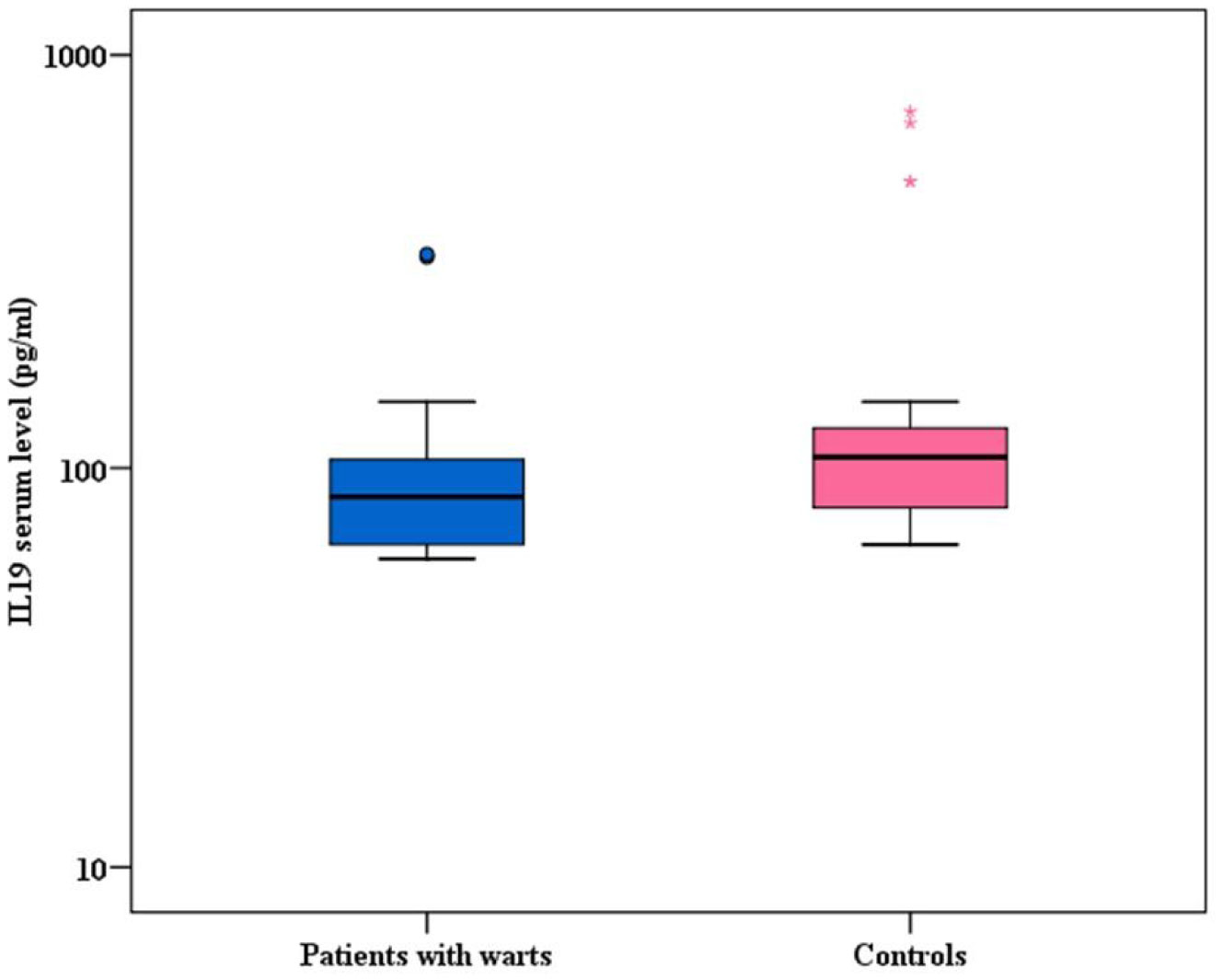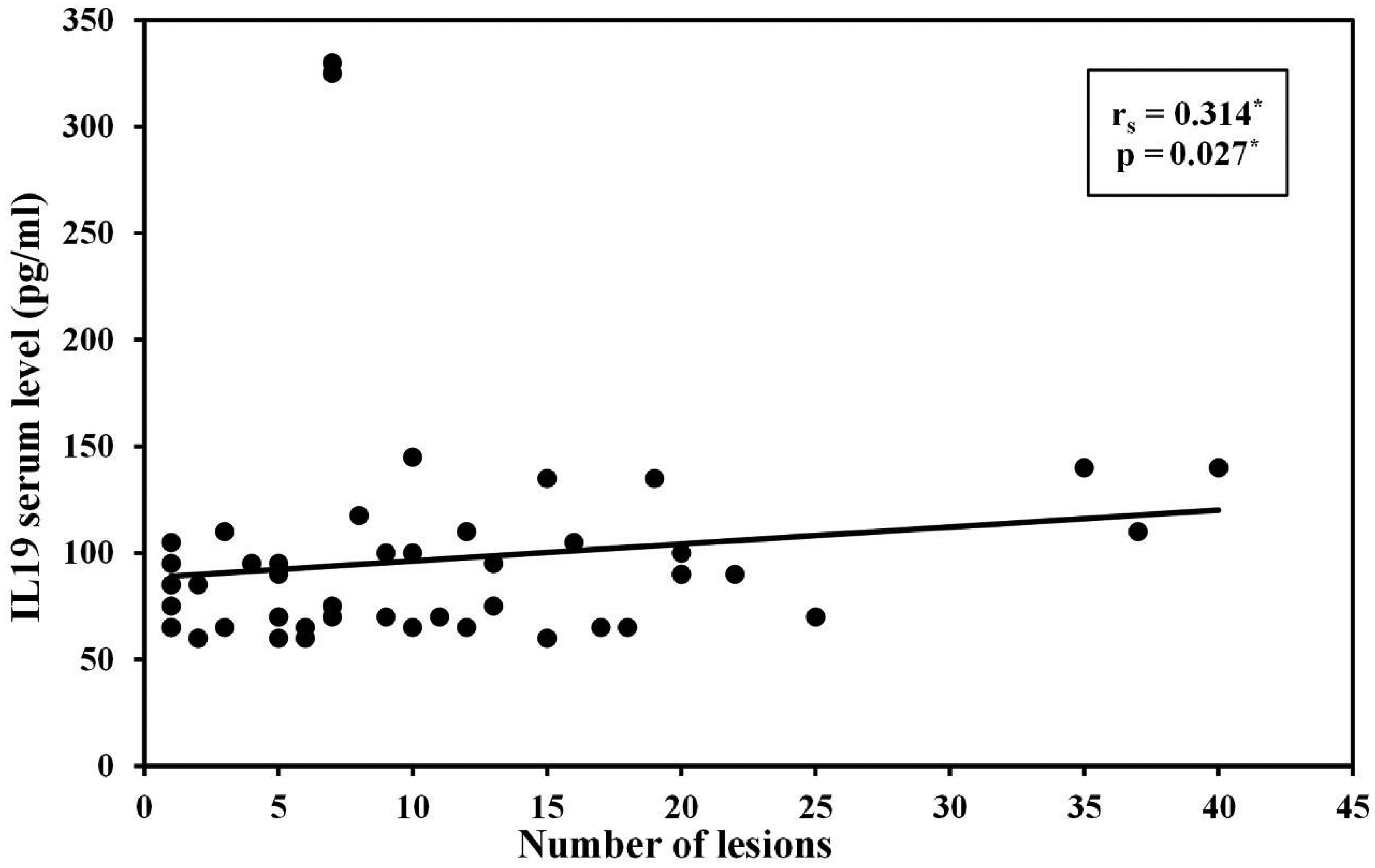1.
Introduction
Warts are common benign tumors caused by human papillomavirus (HPV) infection. Warts are classified into common warts (verruca vulgaris), plane warts (verruca plana), plantar warts and genital warts (condyloma acuminatum) [1]. HPV infections, in most cases, are self-limiting and can be eradicated by an effective cell-mediated immune response. High-risk HPV types are capable of shifting immune response from T-helper (TH) 1 to TH2 which enhances disease progression [2].
Interleukin (IL)-19 is expressed in immune cells such as stimulated and naive monocytes, activated and naive B cells and non-immune cells such as epithelial cells and keratinocytes [3]. IL-19 signaling is mediated by IL-20 receptors expressed in non-immune cells such as keratinocytes and in immune cells including natural killer cells, monocytes, B cells and T cells [4]. IL-19 administration was found to shift T cell maturation away from the pro-inflammatory TH1 cells and toward the anti-inflammatory TH2 cells. It induces IL-4 and IL-13 and decreases interferon-gamma production in T cells [5].
Considering the lack of prior studies that have investigated IL-19 expression in HPV infection, this study aimed to evaluate the serum level of IL-19 in patients with warts compared to control subjects to highlight its possible role in the immunological response to HPV infection.
2.
Patients and methods
2.1. Study design
Fifty patients with warts and 50 healthy controls participated in this case control study. Patients were selected from the Dermatology Outpatient Clinic at Suez Canal University Hospital, Ismailia, Egypt. The clinical pathology laboratory executed the laboratory tests. The Institutional Review Board and the Research Ethics Committee, Faculty of Medicine, Suez Canal University, both provided their approval to the study on the first of July 2020 with the approval number 4217. Age and sex matched healthy control participants who had no history of autoimmune diseases, malignancy, asthma or allergic skin conditions were prospectively recruited from blood donors. To participate in the study, every participant signed a written informed consent. The researchers identified warts by examining for hard verrucous papules or verrucous endophytic proliferation (palmoplantar warts). All patients underwent history-taking and dermatological examination that included an inspection of their mucosal surfaces, periungual areas, genital and perianal areas with an emphasis on the site, number, disease duration and clinical type of warts as well as whether the warts had developed for the first time or had returned following prior treatment.
2.2. Evaluation of IL-19 serum level
Each participant in the study had five milliliters of venous blood drawn from their peripheral veins and placed in sterile serum separator tubes. The samples were centrifuged at a speed of 3000 rpm for 20 minutes following a 20-minute incubation period at room temperature. After being separated, the serum was put into storage at −20 °C until use. Enzyme-Linked Immune-sorbent Assay (ELISA) was used to measure the level of Interleukin 19 in serum using a commercial IL-19 ELISA Kit (catalog number: SL1906Hu; Sun Long Biotech, China; sensitivity: 0.8 pg/ml; range of assay: 3.3 pg/ml – 200 pg/ml). The technique utilized in this kit was Sandwich-ELISA. An antibody specific to Interleukin 19 had been pre-coated on the Micro Elisa strip plate included in this kit. Standards or samples were added to the wells. Then, each sample received a Horseradish Peroxidase (HRP)-conjugated antibody specific for IL-19. Then, each Micro Elisa strip plate well received an addition of an antibody specific for IL-19 that had been HRP-conjugated. Free parts were removed by washing. Each well was filled with the tetramethylbenzidine substrate solution. Only the wells containing IL-19 and HRP-conjugated IL-19 antibody displayed blue coloration before changing to yellow once the stop solution was added. Spectrophotometric measurements of the optical density (OD) were made at a wavelength of 450 nm. The OD value is correlated with the level of IL-19. By comparing the samples' OD to the standard curve, it was possible to determine the amount of IL-19 present in each sample.
2.3. Statistical analysis
Statistical Package for the Social Sciences version 20.0 software was used to analyze the data (Armonk, NY: IBM Corp.). Number and percent were used to describe qualitative data. The normality of the distribution was confirmed using the Kolmogorov-Smirnov test. The range (minimum and maximum), mean, standard deviation, median and interquartile range were used to characterize quantitative data. Student's t-test and Mann Whitney tests for quantitative variables with normal distribution, the Kruskal Wallis test for quantitative variables with abnormal distribution, the Chi-squared test for categorical variables and Spearman's correlation were used. Result significance was assessed at a 5% level of confidence (P < 0.05).
3.
Results
3.1. Demographics of the study participants
Thirty-two (64%) patients were females, and 18 patients were males (36%). The mean of patients' age was 31.32 ± 14.48 years (range 5 to 65 years). Twenty-three control participants were female (46%) while 27 were males (54%). The mean age of control participants was 27.60 ± 7.28 years (range 8 to 47years). There was no statistically significant difference in age or sex between patients and controls (Table 1).
3.2. Clinical data of patients
The mean duration of warts was 21.04 ± 24.60 months (range: 1 – 84 months). The mean number of warts was 10.50 ± 9.47 warts (range: 1 – 40 warts); 42 (84%) patients had multiple warts, compared to 8 (16%) patients who had a single wart. According to the clinical classification of warts, 34 (68%) patients had common warts; of them, 2 (6%) patients had filiform warts, while 7 (21%) patients had periungual warts. Meanwhile, 4 (8%) patients had both plane warts and common warts, compared to 2 (4%) patients who had both palmoplantar and common warts.
There were 10 (20%) patients who had warts in multiple body sites, compared to 40 (80%) patients who had warts only in one location; 26 patients (52%) had warts for the first time, while 24 patients (48%) had recurrent warts after previous treatment (Table 2).
3.3. Serum level of IL-19
Serum level of IL-19 in patients ranged from 60.0 to 330.0 pg/mL, with a mean of 96.65 ± 53.22 pg/mL, while in control subjects, they ranged from 65.0 to 730.0 pg/mL with a mean of 141.0 ± 142.55 pg/mL (Table 3). Patients with warts had significantly lower serum levels of IL-19 than control participants (P = 0.003) (Figure 1).
Additionally, there was a significant positive correlation between the number of warts and serum level of IL-19 (P = 0.027) (Table 4, Figure 2).
On the other hand, there was no relation between IL-19 serum level and other clinical data of patients with warts (Table 5).
4.
Discussion
Approximately 50% of HPV infections resolve in six months due to effective cell-mediated immune response, and in around 90% of cases the virus become undetectable within 5–7 years [6]. Recent research contradicts the theory of virus clearance. Since virus reactivation is common among immune-compromised patients, there is a doubt that the virus is indeed cleared. It is rather conclusive that it is under good immune control, giving rise to undetectable viral load or latency [7].
Many immunological mechanisms interact in the process of virus clearance, including innate and adaptive immunity. Although these mechanisms are highly effective, the virus has developed multiple counteracting mechanisms to fight the immune response, ultimately leading to virus persistence or rather latency. Moreover, the virus has developed mechanisms that can take over the immune system, creating a chronic pro-inflammatory state advancing to carcinogenesis and tumor progression [6],[7].
Interleukin-19 belongs to interleukin 10 cytokines family and constitutes a sub-family with IL-20, IL-22 and IL-24. IL-19 was shown to stimulate the production of anti-inflammatory TH2 cytokine in T lymphocytes in a positive feedback loop, increasing IL-4-positive and decreasing interferon γ-positive lymphocytes [8].
Little is known about the biological effects of IL-19, particularly in viral infections. To date, this is the first study to evaluate serum level of IL-19 in patients with warts. This study showed a significant decrease in IL-19 concentration in the sera of patients with warts in comparison with controls. IL-19 stimulates mainly TH2 anti-inflammatory immune response [5], whereas the immune response to HPV infection relies mainly on TH1 and cytotoxic T cells [9]. As all the enrolled patients were immune-competent, the low level of IL-19 might indicate an attempt of the immune system to maintain effective TH1 cell mediated immune response in order to eradicate HPV and depress its transmission. This low IL-19 level, however, was inadequate to elicit a significant TH1 immune response capable of eradicating HPV infection. The study also found that IL-19 level was positively correlated with the number of warts. Thus, patients with multiple warts had higher levels of IL-19 than patients with single or fewer warts, but their IL-19 levels remained lower than healthy controls. This elevated level in patients with multiple warts might have shifted the immune response slightly towards the TH2 profile, leading to increased viral load and multiplicity of lesions.
Notably, studies with polyI:C, a synthetic RNA analogue that resembles viral RNA and induces the synthesis of type 1 interferon and inflammatory mediators, indicated that in IL-19 defective mice, the production of several mediators was increased. Among them are IL-6, IL-12, CCL5, CCL2 and CXCL1. CCL2 and CCL5 are chemokines that play critical roles in viral infection by activating natural killer cells. The authors concluded that IL-19 could interfere with host defense mechanisms for viral infections by suppressing the release of mediators in response to polyI:C [10].
Interestingly, previous studies reported that IL-19 administration induced cell apoptosis via enhancing tumor necrosis factor-a production and that blockage of its receptors reversed its apoptotic effects [11],[12]. IL-19 low level may therefore contribute to epidermal hyperplasia encountered in HPV infections.
Interleukin-17 serum level was observed to be lower in patients with recalcitrant warts than in control subjects [13]. Interestingly, IL-17 was found to enhance the production of IL-19 in keratinocytes [14]. Low IL-17 level in patients with warts is consistent with our finding of low IL-19 level.
Interleukin-10, whose gene is structurally similar to the IL-19 gene and is located head to head with the IL-19 gene, was investigated in HPV infections. In the presence of HPV oncoproteins, IL-10 was found to function as an anti-inflammatory agent and was highly expressed in tumor cells, and its expression was directly proportional to the development of HPV-positive cervical cancer [15]. Additionally, cervical cancer cells transfected to express the HPV E2 protein induce elevated levels of IL-10 messenger RNA in HPV-infected cells. The elevated expression of IL-10 may allow for virus persistency, the transformation of cervical epithelial cells and consequently cancer development [16].
Interleukin-22, another cytokine from the IL-10 family, has previously been assessed in patients with warts. IL-22 serum level in patients with warts was significantly greater than in control subjects and correlated positively with the number of warts. Patients with recurring warts following prior treatment exhibited significantly higher levels than those with newly developing warts. IL-22, a proinflammatory cytokine, may be involved in the immunological response to HPV by enhancing keratinocyte production of anti-microbial peptides [17].
Studies with larger sample size assessing tissue expression of IL-19 in patients with warts, investigating its serum level and tissue expression before and after wart treatment by different modalities and detecting IL-19 gene polymorphism in patients with warts, especially recalcitrant warts, are recommended. Further prospective studies that compare IL-19 serum level in patients with spontaneous resolution of warts or warts responding to treatment versus patients with recalcitrant warts are recommended to confirm the role of IL-19 in the immune response to HPV.
5.
Conclusion
Serum IL-19 level was significantly lower in patients with warts, and this low level might have a possible role in enhancing the cell-mediated immune response against HPV infections.









 DownLoad:
DownLoad:





